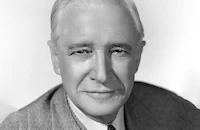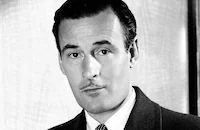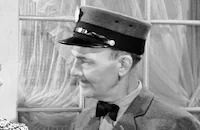Grand Central Murder

Brief Synopsis
Cast & Crew
S. Sylvan Simon
Van Heflin
Patricia Dane
Cecilia Parker
Virginia Grey
Samuel S. Hinds
Film Details
Technical Specs

Synopsis
As their train pulls into New York's Grand Central Station, two policemen lose their charge, convict "Turk," who sneaks away to telephone Broadway entertainer Mida King, whom he threatens. Terrified after finding an Ace of Spades under her door, Mida leaves to go to her wealthy boyfriend David V. Henderson's private railroad car. Meanwhile, private detective "Rocky" Custer and his wife Sue run into Turk, whom Rocky has been trying to free by finding new evidence for his retrial for murder, and advices him to give himself up. More police soon arrive, and reveal that Turk is now wanted for the murder of Mida, who has just been found dead in the bathroom of the private car. While they are investigating, the police see a fleeing Paul Rinehart, who was once married to Mida, and take him to the station, along with Turk, who has been apprehended. Inspector Gunther, a Coca-Cola drinking detective, then has his men round up everyone who might be involved in the case. Ramon, Mida's stepfather and a self-proclaimed psychic, is the first to relate his story: He goes to see Mida late one night and hears her tell Rinehart to stop blackmailing her. Ramon then tells her that the cards have predicted her death. Now Pearl Delroy, Mida's maid, relates her story: A few years before, Pearl, a singer in a Broadway show, meets Mida and invites her to share an apartment. Mida, who is very ambitious, attracts wealthy men, then sells their gifts for cash and stashes it away. She inexplicably marries ne'er-do-well Rinehart, then divorces him. Two years later, when Pearl runs into Mida again, she is seeing Turk, who later introduces her to Broadway theater owner Frankie Ciro. Soon Pearl becomes Mida's maid and confidant. Frankie helps Mida to get several successful Broadway show roles, but she drops him for wealthier men. After using her own money to back a show that flops, however, she again goes back to Frankie. Soon she meets multi-millionaire David, whom she was planning to marry the night she died. Pearl then says that Roger Furness, a millionaire whose daughter Constance had been engaged to David, tried to buy Mida off for $50,000, but she merely laughed at him. During the interrogations, Gunther has been telephoning the coroner to determine exactly how Mida died, but the autopsy has not yet been completed. When Gunther returns to the suspects, Ramon falls over dead, apparently from a heart attack. Rocky, who keeps interrupting the questions, much to Gunther's consternation, finally goads Gunther into moving everyone to the theater. There Baby, Pearl's daughter, reveals that she saw Frankie follow Mida that night. Frankie then tells his story: After Mida runs out of the theater, he follows her to the railroad car and begs her to return for the second act. She tells him about Turk's escape and says that she is going to marry David, divorce him and return to do another show with Frankie. Rocky now suggests that Constance also might have killed Mida over David, and she reveals that just after David told her and her father that he was going to marry Mida, she and her father went to see her show: When Mida doesn't appear in the second act, Constance goes to David's private car and runs into him. They go into the car together and David finds Mida's body. Rocky suggests that David overheard Mida's conversation with Frankie and strangled her, even though the cause of Mida's death is still unknown. Rocky then suggests that they go to the railroad car. While Gunther questions the others, Rocky inadvertently receives the call from the coroner, who reveals the cause of Mida's death. Rocky returns to the suspects and tries to recreate the murder scene. He asks Constance to go into the railroad car's shower, just as Mida had. After Rocky reveals that the murderer hooked up the rail current to the water supply pipe, Furness confesses that he killed Mida because she hurt Constance, then killed Roman by poisoning him because Ramon observed his murder and tried to blackmail him. Confronted with his crime, Furness runs away, but is electrocuted when he falls on the track.

Director

S. Sylvan Simon
Cast

Van Heflin

Patricia Dane

Cecilia Parker

Virginia Grey

Samuel S. Hinds

Sam Levene

Connie Gilchrist
Mark Daniels

Horace Mcnally

Tom Conway
Betty Wells
George Lynn

Roman Bohnen

Millard Mitchell
Arthur Space

Frank Ferguson
John Maxwell
Frank Moran
Tom Dugan
William Tannen

Lee Phelps
Harry Strang
Robert E. O'connor

Ralph Dunn
Eddy Chandler

John Butler
Arthur Q. Bryan
Evalene Bankston
Harry Tyler

Joe Yule
Christine Teague
Walter Soderling
Sam Mcdaniel
Aileen Haley
Norman Abbott
Bob Ryan
Clark Ross
Bert Roach
Crew
George Folsey
Cedric Gibbons
Hayes Goetz
Sydney Guilaroff
Eddie Imazu
Gil Kurland
Conrad Nervig
Peter Ruric
Douglas Shearer
Shoup
David Snell
Edwin B. Willis
B. F. Zeidman

Photo Collections
Film Details
Technical Specs

Articles
Grand Central Murder
The victim of the titular crime was the gorgeous and obviously well-kept cabaret star Mida King (Patricia Dane), and the exact scene was a private railroad car, alone in its Grand Central Station siding with no obvious way in or out. The dyspeptic Inspector Gunther (Sam Levene) and his slow-witted second Doolin (Millard Mitchell) have no shortage of persons of interest in the matter. There's Mida's ex-boyfriend, the hood Turk (Stephen McNally), who had used a brief escape from police custody to make the death threat that drove her into the car for hiding. There's the polished gangster Frankie Ciro (Tom Conway), who backed Mida's show-business rise, and conspired with her on the frame-up that took Turk out of the picture.
There's the private car's owner, David Henderson (Mark Daniels), the handsome old-money heir who was Mida's ultimate prize; his jilted fiancée Constance Furness (Cecilia Parker); and her magnate father, Roger Furness (Samuel S. Hinds), who had unsuccessfully attempted to buy Mida off. There's Pearl Delroy (Connie Gilchrist), Mida's once-burlesque crony and now-resentful personal maid, and her Lolitaesque daughter Baby (Betty Wells), who's also Mida's understudy. Let us not forget Mida's stepfather Ramon (Roman Bohnen), a phony spiritualist that Mida cut off financially; and Paul Rinehart (George Lynn), a maintenance functionary at the station who also happened to be Mida's ex-husband.
Rounding out the crowded field are the small-time PI Rocky Custer (Heflin) and his tart-tongued spouse Sue (Virginia Grey), drawn into the whole mess by Turk, who'd retained Custer to find exculpatory evidence in the hope of winning him a new trial. Gunther's got no love for either Custer or his attitude, but concedes to the canny investigator's working of the clues until killer, motive and opportunity align just right.
Heflin brought plenty of edgy charm to his central performance, and Levene, who had been Broadway's first Nathan Detroit in the original run of Guys and Dolls, made an ideal foil--their chemistry is such that one take where they apparently cracked each other up made the cut. Conway, whom Hollywood seem to lightly regard as a cost-effective alternative to his younger brother George Sanders, offered his expected brand of suave menace, and lifelong character heavy McNally received a nice early showcase.
The yummy brunette contract starlet Dane certainly brought the physical prerequisites to the femme fatale. Married for a time to bandleader Tommy Dorsey, she essentially committed career suicide in the mid-'40s when she told a critical MGM executive where to get off, and she only made sporadic screen appearances thereafter. The attractive Grey made a winsome complement to Heflin; they actually made their respective big-screen farewells in the same assignment, the disaster flick Airport (1970), which offered Heflin's memorable turn as the hijacker.
The proceedings were kept humming at a lively pace by director S. Sylvan Simon, who lent his capable hand to plenty of serviceable second-feature fare for Universal and MGM (such as Red Skelton's "Whistling" vehicles) from the late '30s through the '40s. He was just starting to break into the upper echelon, having served as producer on Born Yesterday (1950) at the time of his death of a heart attack at age 41.
Producer: B.F. Zeidman
Director: S. Sylvan Simon
Screenplay: Peter Ruric, based on the novel by Sue MacVeigh
Cinematography: George J. Folsey
Art Direction: Cedric Gibbons
Music: David Snell
Film Editing: Conrad A. Nervig
Cast: Van Heflin ('Rocky' Custer, Patricia Dane (Mida King), Cecilia Parker (Constance Furness), Virginia Grey (Sue Custer), Samuel S. Hinds (Roger Furness), Sam Levene (Inspector Gunther).
BW-73m. Closed captioning.
by Jay S. Steinberg

Grand Central Murder
Quotes
Trivia
Notes
According to various news items in Hollywood Reporter Donna Reed and Reginald Owen were originally cast, but did not appear in the film. Gertrude Short, Dick Rich and Gayne Whitman were also cast, but their appearance in the released film have not been confirmed. Grand Central Murder marked the motion picture debut of actor Horace McNalley, who changed his name to Stephan McNalley for the 1948 film Rogue's Regiment and retained the latter name throughout the rest of his career.















